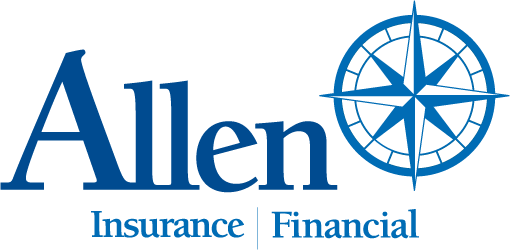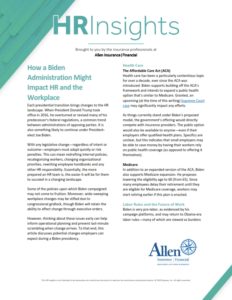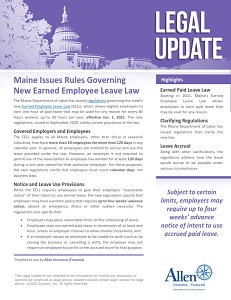December is the “giving season,” when many people consider using their wealth to help others. Because of the urgent need for generosity presented by the COVID-19 pandemic, you may be looking for ways to stretch your charitable donations. As always, the use of tax-efficient giving strategies can help them go further.
This year, it’s also important to be aware of the tax incentives for philanthropy included in the Coronavirus Aid, Relief, and Economic Security (CARES) Act. The summary below explains how you can maximize these tax-efficient giving incentives during the final weeks of 2020. Two common vehicles for charitable planning—now and in the future—are also covered.
CARES Act Tax Incentives
These incentives, which are set to expire on December 31, 2020, apply only to cash gifts to public charities made by individuals or corporations. Regarding your 2020 tax return, here’s what you need to know:
Are you taking the standard deduction? If you’re not itemizing, you can take an “above-the-line” deduction of up to $300 for cash gifts to charities. The amount you claim will reduce your adjusted gross income (AGI). What about married couples filing jointly? As of this writing, your deduction also seems to be limited to $300, according to IRS draft instructions.
Are you itemizing deductions? Typically, annual charitable deductions are capped at a percentage of a taxpayer’s AGI. For individuals, this cap has been set at 60 percent since 2017. Under the CARES Act, however, you may deduct up to 100 percent of your AGI for gifts of cash to a public charity in 2020. This rule excludes gifts to a donor-advised fund (DAF). For corporations, the AGI cap for cash gifts, previously set at 10 percent, has been raised to 25 percent for the year.
- For both individuals and corporations, any unused deduction under this cap may be carried forward for five years, which can lead to the planning opportunities discussed below. The cap for gifts of appreciated assets has not changed.
Planning Opportunities
If you wish to fund large charitable gifts this year, the 100 percent AGI cap offers huge advantages. Here are several ways this incentive could help you manage high-income events:
- Stock options and lump-sum payouts. If you’ve exercised nonqualified stock options from your employer out of concern for market volatility or received a large lump-sum severance package as a result of a layoff, charitable gifts can help offset the tax burden.
- Roth conversions. If you’d like to make a large Roth conversion this year, you could also make a large charitable gift to offset the tax liability of the conversion. This strategy is especially beneficial because traditional IRAs have become a less attractive way to leave money to heirs since the 2019 passage of the SECURE Act, which requires most IRA beneficiaries to empty their inherited IRA within 10 years.
- Business sale. Let’s say you have an expected AGI of $1 million this year due to a business sale. You could make a charitable contribution that would completely offset the year’s income.
- Combining gifts. Although the CARES Act incentive applies only to cash gifts, the IRS does permit taxpayers to combine different types of gifts. For instance, you could maximize your 30 percent AGI cap for gifts of appreciated assets. The 100 percent AGI cap would be reduced by that amount, but you would still be able to deduct another 70 percent of your AGI by making cash gifts.
Qualified Charitable Distributions (QCDs)
A QCD is a direct transfer of funds from an IRA, payable to a qualified charity. Although the CARES Act allows IRA owners to skip required minimum distributions (RMDs) in 2020, the rules for QCDs have not changed. If you own an IRA (including an inherited IRA) and are 70½ or older, you can make tax-free distributions of up to $100,000 payable to public charities (excluding DAFs).
Here are some ways a QCD could help control your income:
- If you decide to take an RMD this year (or must do so in the future), a QCD could be used to satisfy the distribution. This strategy would remove the tax burden associated with taking the distribution as ordinary income.
- A QCD is not reportable as part of your AGI, which limits its impact on the taxation of social security benefits.
- In future years, a QCD could also limit the impact of income on Medicare premiums, which are based on your AGI from two years prior.
Charitable Remainder Trusts (CRTs)
A CRT can help you (or your beneficiary) spread the tax liability on the sale of appreciated assets over many years. This may result in paying a lower overall effective tax rate. Let’s look at how this works:
- A CRT pays an income stream to a noncharitable beneficiary (or beneficiaries) for a term of years or for life. At the end of the income term, the remaining assets in the trust are distributed to a charity.
- When you move assets into a CRT, you receive a charitable contribution deduction based on the present value of the remainder interest set to pass to the charity at the end of the income distribution term.
- If you contribute appreciated assets (e.g., investment assets, closely held business interests, real estate, or collectibles), those assets can be sold without creating a tax liability to the trust itself.
As you can see, the primary benefit of a CRT is that the trust is exempt from taxes. But that does not mean taxes are entirely avoided for beneficiaries. In fact, the distributions to the income beneficiaries are taxable based on four buckets of income: ordinary income, capital gains, tax-free income, and return of principal. Each year, when the CRT makes its income distribution, it first pulls the funds available from accumulated ordinary income, such as interest and dividends, before distributing other types of income. The beneficiaries would be subject to the taxation rules in place for these types of income.
Need Additional Information?
If you’re interested in exploring these options, please contact me. We’ll talk through how these giving strategies can help you meet today’s urgent need for generosity—and further your visions for doing good.
This material has been provided for general informational purposes only and does not constitute either tax or legal advice. Although we go to great lengths to make sure our information is accurate and useful, we recommend you consult a tax preparer, professional tax advisor, or lawyer.








